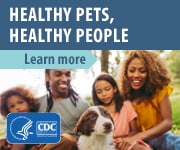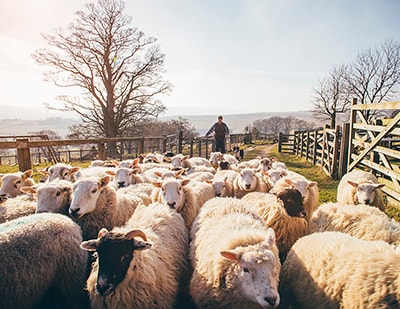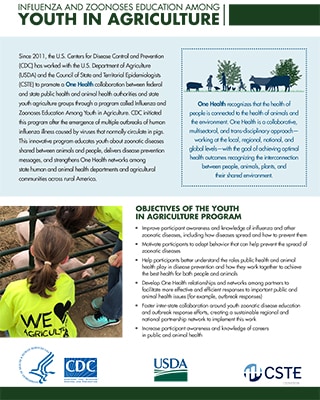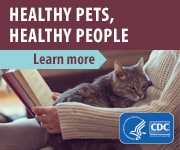CDC’s One Health Office: What We Do
The CDC One Health Office works within the United States and with other countries and regions to build strong partnerships and takes a strategic, targeted approach to control and prevent zoonotic and emerging infectious diseases and other One Health issues.
The office works with partners in other countries and across federal, state, tribal, local, and territorial governments; industry; professional organizations; academic partners; and nongovernmental organizations to:
- Coordinate partners to address One Health challenges
- Prepare for and respond to outbreaks and public health emergencies, such as Ebola, Zika, and COVID-19
- Build One Health capacity and strengthen global health security through training and tool development
- Strengthen surveillance and information sharing across public health, agriculture, wildlife, and other sectors
- Educate people on ways to prevent diseases they can get from pets, wildlife, and farm animals
- Develop guidance for veterinarians, public health officials, wildlife professionals, animal health officials, and many others
Below are examples of One Health Office priority projects in the United States and abroad.
Our Projects

CDC’s One Health experts are working globally to implement a One Health Zoonotic Disease Prioritization process that builds collaboration across disciplines and sectors to focus limited resources on preventing, detecting, and responding to those zoonotic diseases of greatest national concern.
The Global Health Security Agenda (GHSA) is an effort by nations, international organizations, and civil society to accelerate progress toward a world safe and secure from infectious disease threats; to promote global health security as an international priority; and to spur progress toward full implementation of the World Health Organization (WHO) International Health Regulations 2005 (IHR) and Joint External Evaluations (JEE) for Improved Health Security, the World Organisation for Animal Health (WOAH) Performance of Veterinary Services (PVS) pathway, and other relevant global health security frameworks.
The One Health Office works with global partners to support the GHSA and further strengthen global health security, including the Quadripartite, made up of WHO, WOAH, the Food and Agriculture Organization of the United Nations (FAO), and the United Nations Environment Programme (UNEP). Office experts contributed to the development of the Tripartite Zoonoses Guide to support countries in taking a multisectoral, One Health approach to address zoonotic diseases. The office provided expertise in the development of implementation tools for the guide, including the Multisectoral Coordination Mechanism Operational Tool (MCM OT) to enhance coordination across sectors and the Surveillance and Information Sharing Operational Tool (SIS OT) to assess the coordinated surveillance capacity of any locality.
The One Health Office supports zoonotic outbreak investigations and emergency responses by conducting surveillance, research, and providing subject matter expertise and technical assistance. During an outbreak or emergency response, the office conducts and coordinates One Health investigations, which involve experts from human, animal, and environmental sectors working together to understand the source and spread.
COVID-19 and One Health
- The One Health Office deployed One Health teams to states to support One Health investigations into domestic and wild animals infected with SARS-CoV-2, the virus that causes COVID-19. These investigations help scientists and health officials better understand how to prevent exposure and spread of SARS-CoV-2. This knowledge is critical in protecting the health and welfare of people and animals.
- The One Health Office developed SARS-CoV-2 surveillance and reporting infrastructure using HHS Protect, CDC’s centralized repository for COVID-19 surveillance data. These surveillance pipelines capture laboratory and epidemiologic data collected during One Health case investigations and help us understand how and why spread between people and animals happens; how spread can be prevented; and allow us to track mutations and variants in animals.
- The One Health Office brought together federal, state, tribal, territorial, and local partners to collaborate and exchange information on the One Health aspects of COVID-19 by creating the One Health Federal Interagency COVID-19 Coordination Group and holding regular State-Federal One Health Update Calls. These collaborations led to the development of guidance related to animals and COVID-19 for pet owners, public health and animal health officials, veterinarians, and other audiences. To reach partners outside government, the office also held regular calls with veterinarians, academic partners, diagnostic laboratory personnel, professional organizations, and more.

The Healthy Pets, Healthy People website provides zoonotic disease prevention messages to educate pet owners, public health officials, veterinarians, human healthcare providers, and others on ways to stay healthy while enjoying pets, farm animals, and wildlife. The One Health Office works with the Pet Advisory Network, breeders and retailers, the National Association of State Public Health Veterinarians (NASPHV), the American Veterinary Medical Association (AVMA), and others to develop and distribute messaging and education about animal-related zoonoses, including those linked to pets.

Zoonoses & One Health Updates (ZOHU) Calls are one-hour monthly webinars that provide timely education on zoonotic and infectious diseases, One Health, antimicrobial resistance, food safety, vector-borne diseases, recent outbreaks, and related health threats at the animal-human-environment interface. Free Continuing Education is available for live calls and recordings.
The One Health Office works closely with the National Association of State Public Health Veterinarians (NASPHV). State public health veterinarians are the local and state professionals who regularly consult with physicians, emergency rooms, legislators, local officials, schools, health departments, and the general public on preventing and controlling diseases that people can get from animals and animal products. NASPHV, in partnership with CDC and others, collaborate on a variety of guidance and recommendations related to the prevention and control of zoonoses.
Since 2011, CDC has worked with the Council of State and Territorial Epidemiologists and the United States Department of Agriculture (USDA) to promote a One Health collaboration between federal and state public health and animal health authorities and state youth agriculture groups through a program called Influenza and Zoonoses Education Among Youth in Agricultureexternal icon. CDC initiated this program after the emergence of multiple outbreaks of human influenza illness caused by viruses that normally circulate in pigs. Youth who are in contact with or work directly with animals are at a higher risk for zoonotic diseases. This innovative program educates youth about zoonotic diseases, delivers disease prevention messages, and strengthens One Health networks among state human and animal health departments and agricultural communities across rural America.
The program has a direct potential reach of 7.2 million youth through 4-H and FFA but can also spread educational messages to their family, mentors, friends, agricultural producers, and others.
- See the Youth in Agriculture Program Overview [PDF – 2 pages].
- See more information on the Influenza and Zoonoses Education Among Youth in Agriculture Program on CSTE’s website.
- Visit the program’s Resource Repository for educational materials.

Read the fact sheet on CDC’s One Health Office and the One Health approach.

Learn about CDC’s One Health Office, its history mission, and its mission.

Contact us with questions, follow us on social media, and sign up for One Health updates.


